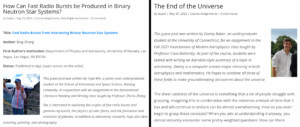Undergraduates, have you ever wanted to write your own Astrobite? Professors, would you like to help make that happen?
At Astrobites, we love to break down complex astronomical topics so that our undergraduate readers can understand them. Not only do our readers benefit, but our authors often come away with a better understanding of the background for the research paper being summarized, the motivation for the research idea, and how it will impact the field as a whole — the same things we want our readers to learn. Inspired by what we have learned from writing our own bites, we realized that writing your own Astrobite could be a much more immersive way for you to learn about a research paper or astronomy in general beyond just reading Astrobites!
In fact, several professors teaching undergraduate and Masters-level courses designed their curricula around having their students write Astrobite-style posts, some of which you may have seen on our website! In this bite, we would like to encourage other instructors to consider having their students write Astrobites and provide examples of the framework you could use to make that happen. (And to any students reading — if this sounds like a cool thing to you, show this bite to your professors!)
Around the world
In the past few years, we have published student bites from five different courses (from three different continents!):
- Foundations of Modern Astrophysics: a sophomore-level undergraduate major course with around 30 to 40 students taught by Professor Cara Battersby (UConn)
- Another Earth: an undergraduate non-major course with around 50 students taught by Professor David Kipping (Columbia University)
- Galaxies and Galaxy Dynamics: a Masters course with around 10 students taught by Professor Claudia Lagos (University of Western Australia)
- Astronomical Literature Reading and Writing: a joint undergraduate-Masters course with around 50 students taught by Professor Zhang Zhiyu (Nanjing University)
- Astrobiology in Science Journalism: an undergraduate non-major interdisciplinary writing seminar as part of UCLA’s Clusters Program with around 20 students taught by graduate student instructor Briley Lewis (UCLA)
The first three were regular astronomy courses that mainly focused on a few topics in astronomy rather than on writing itself as a primary goal, while the last two actually did focus primarily on writing.

Figure 1. This could be you! (or your students!) Coffee not required. Adapted from Lovely Mockups.
Initial setup
Students were broadly tasked with writing a summary of a research paper that emulated the style we use on Astrobites. Battersby and Lagos permitted students to write Astrobites that were quite a bit longer than a typical Astrobite post. Lagos also gave out two of these assignments per semester. Battersby’s Astrobite assignment differed the most in that she had students write a summary of a topic in astronomy instead of a specific paper. Most of these courses let students pick their own research papers (or topics) to write about, except for Lewis and Lagos’s courses in which they picked the papers themselves so that they were related to the course material. Kipping also required students to pick papers related to the course material, while Battersby had to approve all of the topics beforehand as a formality.
While preparation for the assignments varied a lot from course to course, there were a few aspects they had in common. Each professor made sure to give their students more time than a typical Astrobite author would need to write their bites. They generally gave out these assignments early on or in the middle of the semester, and gave students at least three weeks to complete the assignment. At the very least, they all also introduced their students to Astrobites and told students to read examples before they began writing their bites. Battersby in particular also recommended giving students specific Astrobites to read as examples, while Lagos similarly discussed specific Astrobites with her students during class.
When introducing the assignment, Battersby provided her students with this project description, which includes a rubric. Lewis first introduced Astrobites through a reading assignment meant to discuss the idea of audience, and then guided her students to write their own article with this assignment description, which includes a rubric and a worksheet on how to analyze scientific papers. Other helpful materials you could provide to your students on how to write a good Astrobite are Haley Wahl’s twitter thread, Mitchell Cavanagh’s presentation guide that he developed for Lagos’s class, or our workshop guide from the 2020 AAS meeting put together and administered by Caitlin Doughty, Stephanie Hamilton, Briley Lewis, and Kate Storey-Fisher.

Figure 2. Two slides from Mitchell Cavanagh’s presentation guide to writing an Astrobite.
Editing and Presentations
Most of the assignments included some type of review process. Battersby had her students peer edit each other’s drafts in groups of three or four, resembling the editing process we have at Astrobites where each bite is edited by another author. With her assignment spanning a month and a half, one of the improvements she made in more recent iterations of the course was to have clear checkpoints before the final submission. This change was made to mitigate student tendencies to do most of the work last-minute. Similarly to Battersby’s course, Zhang randomly assigned students to anonymously peer review each other’s drafts so that every student received three reviewer reports that they could use to improve their bites. Zhang encouraged students to make their final submission at any step during the process, as long as they felt confident about their work. Both Lagos and Zhang each offered to read their students’ drafts before their final submissions if they were interested, and Lewis gave formative feedback to each student as part of the assignment.
Beyond a review process, three of the courses complemented the bites with presentations. Zhang had students give a ten-minute presentation on a different paper that could be related to the one they were writing about. Battersby incorporated students giving one to two minute pop talks on their bites after they were submitted. Lagos had students give seven-minute presentations followed by a question and answer section. She recommended scheduling these talks before the bites were due so that they could help students improve their bites.
Feedback
As with other facets of your astronomy courses, the point is to have students do something that is beneficial to them! With regard to what was their favorite part of the course, one of Battersby’s students stated: “Probably the astrobite since it was a chance to relate astrophysics to other interests, which reinforces both topics better than regular old studying.” Another student commented: “The astrobites were awesome, I loved being able to go more in-depth about something I care about and also being able to learn from other people’s presentations.” The best sign that Lagos’s course was a success is that it influenced two of the students from her course to become Astrobite authors: Katy Proctor and Mitchell Cavanagh. Katy noted, “I found that I really enjoyed the process and that it was a good way to actually force me to understand the papers.” Mitchell commented, “I found it immensely rewarding to have the opportunity to inject some creative writing into what would otherwise have been yet another dry, formal assignment. Writing an Astrobite summary made me appreciate the value of distilling complex papers into short, approachable summaries that are engaging and fun to read!”
Keep in mind, not all students are going to like the idea of writing. Battersby’s recommendation was to point out to the students “not to think of this as extra work but as a chance to dive deep into a topic that we won’t cover in detail in class.” Lewis cautioned that many students “will be intimidated or feel unprepared for writing, and may even be unprepared to write about science”; however, she noted that “this is a great opportunity to teach valuable discipline-specific writing skills and build their confidence as communicators.”
Bonus: Publishing as Guest Posts
After these assignments ended, students who wrote more polished bites had the opportunity to submit them to our website as guest posts, which we hope is a fun incentive for students to do a good job writing their bites. Like our regular bites, we paired up each student with an editor to polish the bites before they were published. You can find the published bites from each class under the Course Assignments category or these specific tags: Battersby’s course, Kipping’s course, Lagos’s course, Zhang’s course, and Lewis’s course.

Figure 3. Two example course assignment bites, one from Zhang’s course and one from Battersby’s course.
We would love to see more undergraduates getting practice writing Astrobite-style posts, and more undergraduates submitting guest posts. If you are a professor or instructor teaching a course where you have students write Astrobites, please let us know (at our email: [email protected]) and we would be happy to organize having some of your students get their bites published here on Astrobites!
Thanks to professors Cara Battersby, David Kipping, Claudia Lagos, and Zhang Zhiyu, as well as authors Mitchell Cavanagh, Katy Proctor, and Briley Lewis for their help in putting this Astrobite together.
Astrobite edited by Briley Lewis
Featured image credit: Adapted from Lovely Mockups



